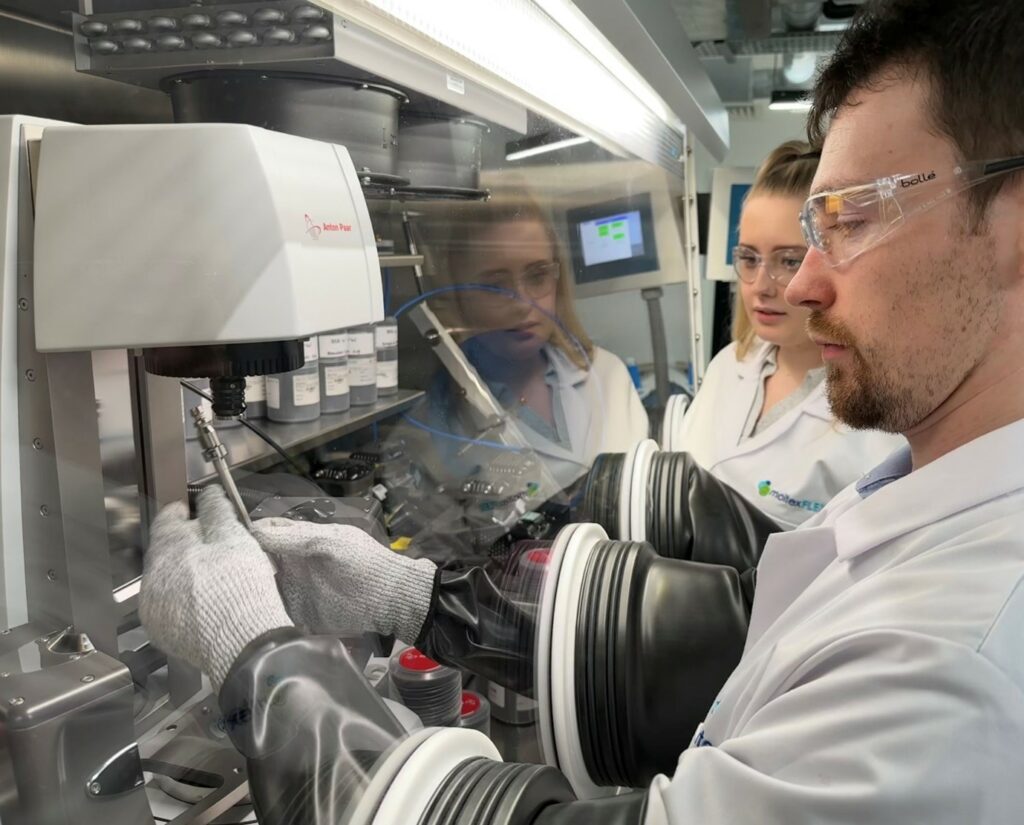 UK-based MoltexFLEX says it has commissioned technology to measure the viscosity and density of molten salts at temperatures up to 1,000°C. The company, together with scientific instruments manufacturer Anton Paar, has installed a rheometer inside a climate-controlled inert gas glovebox at the MoltexFLEX laboratory in Warrington, Cheshire. The test rig is now operational and has started providing data.
UK-based MoltexFLEX says it has commissioned technology to measure the viscosity and density of molten salts at temperatures up to 1,000°C. The company, together with scientific instruments manufacturer Anton Paar, has installed a rheometer inside a climate-controlled inert gas glovebox at the MoltexFLEX laboratory in Warrington, Cheshire. The test rig is now operational and has started providing data.
Rheometers measure the viscosity and density of different materials at varying temperatures. MoltexFLEX, a subsidiary of Canada’s Moltex Energy, is using its new rheometer to test the fluoride salts. The company is planning to use it as the fuel and coolant for its FLEX reactor, the design for which it launched in October 2022. MoltexFLEX says the reactor uses molten salt technology in an unprecedented way. With no moving parts, the FLEX reactor is simple in both design and operation, the company said. It can respond to changes in energy demand – automatically entering an idle state or returning rapidly to full power – making it an ideal complement to wind and solar power.
“The FLEX reactor relies on natural convection rather than pumps to circulate the molten salt coolant, and this is sensitive to viscosity and density, so accurate information of these parameters at different temperatures is vital,” says MoltexFLEX lead chemist Phil Quayle.
There is little available information on how the kinds of fluoride salts used in the FLEX reactor behave at high temperatures. Data on their density and viscosity is difficult to gather reliably as the salt can easily become contaminated by oxygen and water, which affects its material properties.
Installing the rheometer inside the glovebox, which is filled with pure nitrogen gas, solves this problem and enables MoltexFLEX’s scientists to get accurate results, the company says. The team has calibrated the rheometer with lower-temperature chloride salts and is now generating viscosity data for the FLEX salts. “Bringing the rheometer capability in-house is a huge step forward in MoltexFLEX’s analytical capability. It enables us to ‘try fast and learn fast’. We can rapidly develop experimental protocols and generate good data sooner,” Quayle notes.
MoltexFLEX research chemist Dr James Moffat, who led the rheometer commissioning process,s says the Anton Paar team “have been fantastically supportive in making this installation possible. “As far as we and Anton Paar know, no-one in the UK has installed a high-temperature rheometer inside a climate-controlled environment like this,” explains chemist Beth Mapley, who is developing procedures for use with surrogate uranium fluoride fuel salt . “It’s really exciting to be able to work on such cutting-edge research.” .
According to Ana-Maria Fuentes, a sales engineer from Anton Paar, the project “has been without a doubt one of our most challenging installations…. We successfully installed a fully functional MCR 302e rheometer with temperature capabilities up to 1,000°C inside an inert glovebox”.
In February, MoltexFLEX was awarded a research grant by the Henry Royce Institute of Advanced Materials (Royce). Using the grant, MoltexFLEX will work with the University of Manchester’s Nuclear Graphite Research Group (NGRG) to investigate how the FLEX reactor’s molten salt coolant interacts with graphite, which is used as a moderator. MoltexFLEX and NGRG scientists will employ the state-of-the-art facilities available in the university’s irradiated materials laboratory to examine the graphite and its response to molten salt exposure in minute detail.
Image: MoltexFLEX chemists Dr James Moffat and Beth Mapley working with the rheometer (courtesy of MoltexFLEX)






